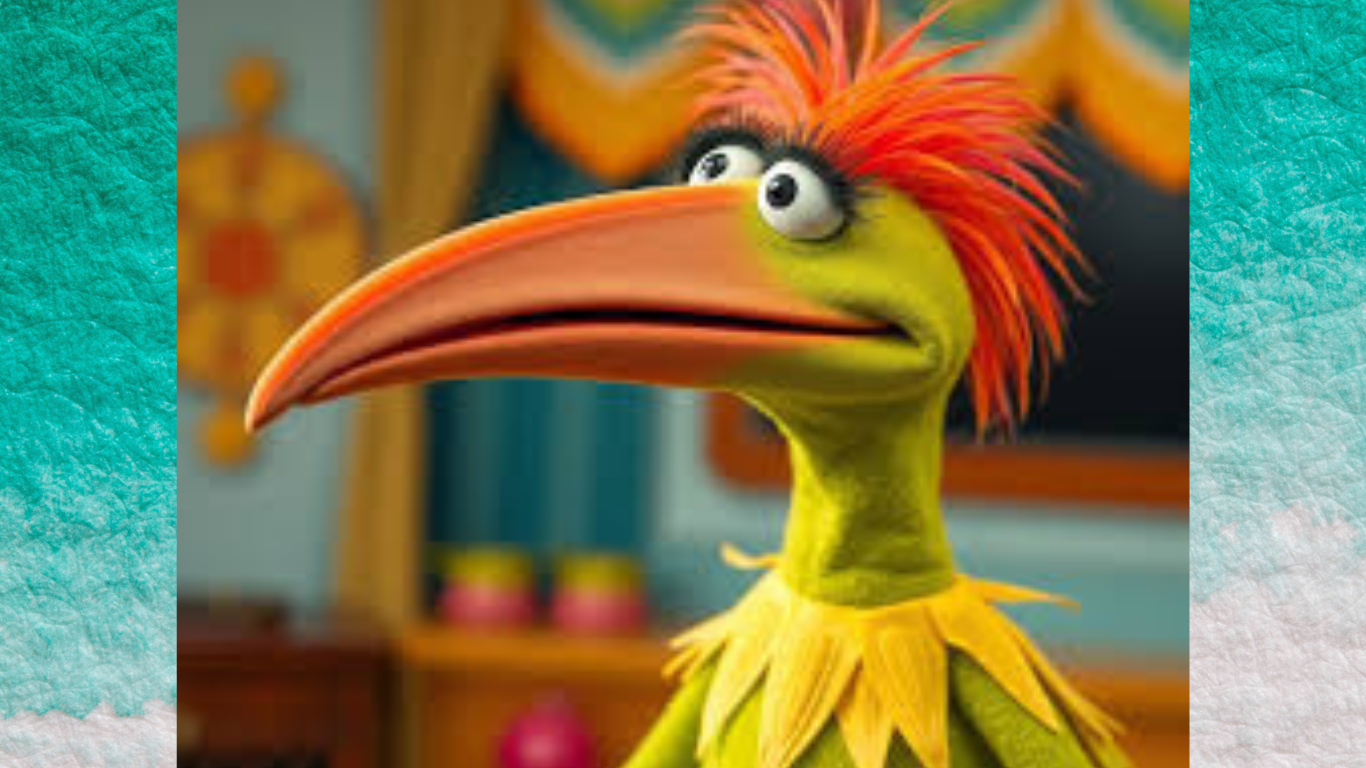Introduction
The world of the Muppets, created by Jim Henson, is filled with colorful and memorable characters that have captured the hearts of audiences for decades. Among the iconic Muppets, one particular character stands out due to its distinctive physical trait—a long, hooked beak. This character, known for its unique appearance and comedic persona, has become a beloved figure in the Muppet universe. In this blog post, we’ll take an in-depth look at the Muppet with a long hooked beak, exploring its origins, design, significance, and cultural impact.
Whether you’re a long-time Muppet fan or a newcomer curious about this iconic character, this comprehensive guide will provide insights into why the Muppet with a long hooked beak has become an unforgettable part of pop culture.
1. Who is the Muppet with a Long Hooked Beak?
When referring to the “Muppet with a long hooked beak,” the character that typically comes to mind is Gonzo the Great. Gonzo is one of the most recognizable Muppets, distinguished by his blue fur, unique hooked beak, and eccentric personality. He has been a central figure in many Muppet productions, including The Muppet Show, Muppet Babies, and various Muppet movies.
a. Character Background and Design
Gonzo first appeared in The Great Santa Claus Switch in 1970, but it wasn’t until The Muppet Show premiered in 1976 that he became a regular character. Originally referred to as a “whatever” or “weirdo,” Gonzo’s species was intentionally left ambiguous, which only added to his unique charm. His distinctive hooked beak, which curls downward, is one of his most defining features, setting him apart from the other Muppets.
His design reflects his unconventional nature, with an appearance that combines elements of different animals while remaining wholly original. The long hooked beak, which is a central part of his face, contributes to his quirky look and aligns with his character’s strange and daring personality.
2. The Evolution of Gonzo’s Character
Over the years, Gonzo’s character has evolved significantly. He started as a bit of a daredevil, performing bizarre stunts and acts of bravery on The Muppet Show. These performances were often met with mixed reactions from the audience within the show, which became a running gag and part of his charm.
a. From Daredevil to Emotional Depth
In the early days, Gonzo was primarily used for comedic relief, often failing spectacularly at his daring feats. However, as the Muppet franchise grew, his character was given more depth and emotional storylines. For example, in The Muppet Movie (1979), Gonzo’s role expanded from that of a stunt performer to a dreamer with aspirations to go to Hollywood.
b. Discovering Gonzo’s Identity
One of the most notable moments in Gonzo’s history came in Muppets from Space (1999), where his species was finally addressed. The film revealed that Gonzo is actually an alien, answering the long-running question about his origins. The movie added layers to his character by exploring themes of identity and belonging, making him more relatable to audiences.
3. Why is Gonzo’s Beak So Iconic?
Gonzo’s long hooked beak is not just a physical feature; it has become a symbol of his identity. The beak contributes to his distinctive silhouette and is instantly recognizable, making him stand out even in a group of diverse Muppet characters.
a. Symbol of Individuality
The hooked beak is emblematic of Gonzo’s unconventional nature. In a world where characters often have clear roles and identifiable species (like Kermit the Frog or Miss Piggy), Gonzo’s ambiguous appearance and long beak symbolize his individuality. His beak serves as a visual representation of his status as an outsider, yet someone who is comfortable with his uniqueness.
b. Comedic Uses of the Beak
In various Muppet productions, Gonzo’s beak has also been used for comedic purposes. It adds to the humor when he performs physical comedy, interacts with other characters, or becomes involved in slapstick scenarios. The long hooked shape allows for exaggerated expressions and reactions, making it an asset in visual storytelling.
4. Gonzo’s Cultural Impact
Gonzo is more than just a Muppet with a long hooked beak; he is a character that has resonated with fans on a deeper level. His storylines often carry themes of self-acceptance, embracing one’s differences, and pursuing dreams despite the odds. These themes have contributed to his popularity and his standing as a beloved character across generations.
a. Influence on Muppet Media
Gonzo has played a significant role in shaping the tone and style of Muppet productions. His offbeat humor, daring stunts, and emotional depth have allowed the Muppets to explore a range of genres, from comedy to drama to science fiction. His presence has brought a unique flavor to Muppet projects, ensuring that each production retains a sense of unpredictability and fun.
b. Connection with Audiences
Audiences often relate to Gonzo because he represents the idea of being different yet still finding a place to belong. His journey from a “whatever” to an alien who embraces his identity resonates with anyone who has ever felt like an outsider. Gonzo’s character teaches viewers that it’s okay to be different and that self-acceptance is a powerful thing.
5. Other Muppets with Unique Features Similar to Gonzo’s Beak
While Gonzo is the Muppet most associated with a long hooked beak, there are a few other Muppets with distinctive facial features or beak-like appearances that have contributed to the diversity of the Muppet cast.
a. Beauregard the Janitor
Beauregard, the janitor from The Muppet Show, is a character with a unique face, including a prominent nose that contributes to his memorable appearance. Though not as hooked as Gonzo’s beak, Beauregard’s facial structure is still a key part of his character design.
b. Camilla the Chicken
Gonzo’s love interest, Camilla the Chicken, also has a notable beak. While it is not long or hooked, it is a defining feature that adds to her character’s charm. Her relationship with Gonzo, despite their vastly different appearances, symbolizes acceptance and love beyond physical differences.
c. Other Bird-Like Muppets
Characters such as Sam the Eagle and Big Bird from Sesame Street also have distinct beaks that play a role in their design. While Sam’s beak is shorter and more rigid, and Big Bird’s is larger and rounder, each beak design helps convey the character’s personality and role within their respective shows.
6. Famous Appearances of Gonzo and His Hooked Beak
Gonzo’s hooked beak has made many appearances throughout Muppet history, each adding to his legacy as a beloved character. Below are some of his most notable appearances:
a. The Muppet Show (1976-1981)
Gonzo was one of the main cast members of The Muppet Show, where his daredevil acts often ended in hilarious failure. His beak and expressive face were used to great effect in the show’s many comedic scenes.
b. The Muppet Movie (1979)
In The Muppet Movie, Gonzo plays a significant role as part of the main group heading to Hollywood. His iconic song “I’m Going to Go Back There Someday” became a fan favorite, highlighting his character’s depth and longing.
c. Muppets from Space (1999)
As mentioned earlier, Muppets from Space was the film that revealed Gonzo’s origins as an alien. The movie focused on his search for belonging and identity, making his beak not just a physical feature, but a part of his mysterious heritage.
d. Muppet Babies (1984-1991, 2018-present)
In Muppet Babies, Gonzo is reimagined as a baby Muppet, retaining his distinctive beak while adding a cuter, more childlike appearance. The animated show allows for even more expressive uses of his beak and facial expressions.
7. Behind the Scenes: Creating Gonzo’s Unique Look
The creation of Gonzo’s character and his unique beak design was the result of Jim Henson’s innovative approach to puppetry. Here’s a look at how Gonzo’s distinctive appearance was developed.
a. Designing the Beak
The original concept for Gonzo’s beak was to make it an exaggerated feature that would emphasize his “weirdo” status. It was crafted with materials that allowed for flexibility and a range of expressions. The curvature of the beak was designed to give him a sad or thoughtful look when needed, adding to his emotional depth.
b. Evolution of the Puppetry
As technology and puppetry techniques improved, Gonzo’s design was refined to enhance his expressiveness. Modern Muppet productions use animatronics and sophisticated puppetry to animate his beak, allowing for more nuanced performances.
8. Fan Culture and Gonzo’s Enduring Popularity
Gonzo’s hooked beak is a fan-favorite trait that has inspired fan art, merchandise, and even cosplay. Muppet enthusiasts celebrate his uniqueness and his place within the Muppet family.
a. Gonzo in Pop Culture
Gonzo’s beak and character have appeared in various parodies, commercials, and cultural references. His image has become synonymous with the Muppets as a whole, representing the playful and unconventional spirit of the franchise.
b. Merchandising and Collectibles
Gonzo-themed merchandise, including plush toys, action figures, and apparel, often emphasizes his long hooked beak, highlighting its iconic status. Fans of all ages can find Gonzo products that celebrate his one-of-a-kind look.
Conclusion
The Muppet with a long hooked beak, Gonzo the Great, is more than just a quirky character; he is a symbol of individuality and self-acceptance. From his origins as a “whatever” to his revelation as an alien, Gonzo’s journey has touched the hearts of many, teaching valuable life lessons about embracing one’s uniqueness. His distinctive beak is not just a physical feature—it’s a symbol of the charm, humor, and emotional depth that make Gonzo an unforgettable character in the Muppet universe.




